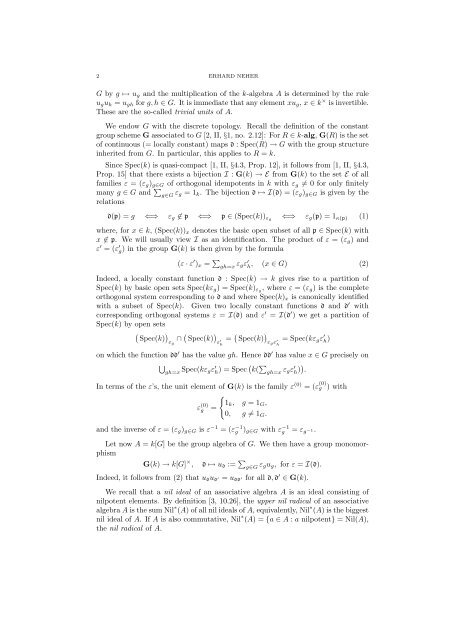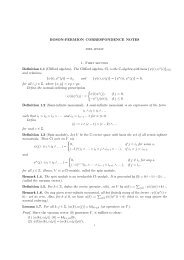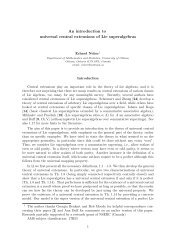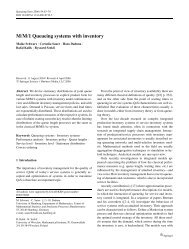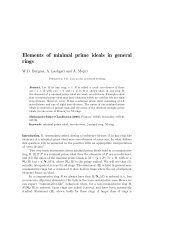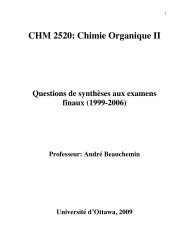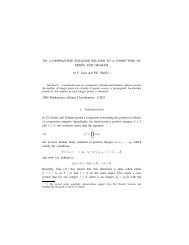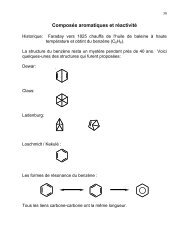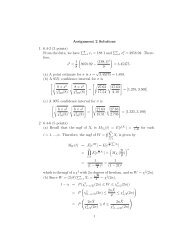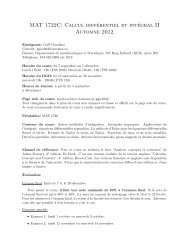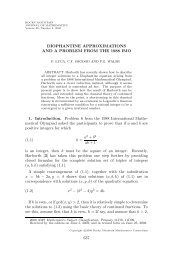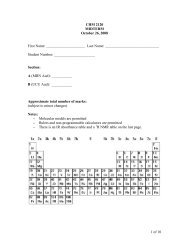invertible and nilpotent elements in the group algebra
invertible and nilpotent elements in the group algebra
invertible and nilpotent elements in the group algebra
Create successful ePaper yourself
Turn your PDF publications into a flip-book with our unique Google optimized e-Paper software.
2 ERHARD NEHER<br />
G by g ↦→ u g <strong>and</strong> <strong>the</strong> multiplication of <strong>the</strong> k-<strong>algebra</strong> A is determ<strong>in</strong>ed by <strong>the</strong> rule<br />
u g u h = u gh for g, h ∈ G. It is immediate that any element xu g , x ∈ k × is <strong><strong>in</strong>vertible</strong>.<br />
These are <strong>the</strong> so-called trivial units of A.<br />
We endow G with <strong>the</strong> discrete topology. Recall <strong>the</strong> def<strong>in</strong>ition of <strong>the</strong> constant<br />
<strong>group</strong> scheme G associated to G [2, II, §1, no. 2.12]: For R ∈ k-alg, G(R) is <strong>the</strong> set<br />
of cont<strong>in</strong>uous (= locally constant) maps d : Spec(R) → G with <strong>the</strong> <strong>group</strong> structure<br />
<strong>in</strong>herited from G. In particular, this applies to R = k.<br />
S<strong>in</strong>ce Spec(k) is quasi-compact [1, II, §4.3, Prop. 12], it follows from [1, II, §4.3,<br />
Prop. 15] that <strong>the</strong>re exists a bijection I : G(k) → E from G(k) to <strong>the</strong> set E of all<br />
families ε = (ε g ) g∈G of orthogonal idempotents <strong>in</strong> k with ε g ≠ 0 for only f<strong>in</strong>itely<br />
many g ∈ G <strong>and</strong> ∑ g∈G ε g = 1 k . The bijection d ↦→ I(d) = (ε g ) g∈G is given by <strong>the</strong><br />
relations<br />
d(p) = g ⇐⇒ ε g ∉ p ⇐⇒ p ∈ (Spec(k)) εg ⇐⇒ ε g (p) = 1 κ(p) (1)<br />
where, for x ∈ k, (Spec(k)) x denotes <strong>the</strong> basic open subset of all p ∈ Spec(k) with<br />
x ∉ p. We will usually view I as an identification. The product of ε = (ε g ) <strong>and</strong><br />
ε ′ = (ε ′ g) <strong>in</strong> <strong>the</strong> <strong>group</strong> G(k) is <strong>the</strong>n given by <strong>the</strong> formula<br />
(ε · ε ′ ) x = ∑ gh=x ε gε ′ h<br />
, (x ∈ G) (2)<br />
Indeed, a locally constant function d : Spec(k) → k gives rise to a partition of<br />
Spec(k) by basic open sets Spec(kε g ) = Spec(k) εg , where ε = (ε g ) is <strong>the</strong> complete<br />
orthogonal system correspond<strong>in</strong>g to d <strong>and</strong> where Spec(k) x is canonically identified<br />
with a subset of Spec(k). Given two locally constant functions d <strong>and</strong> d ′ with<br />
correspond<strong>in</strong>g orthogonal systems ε = I(d) <strong>and</strong> ε ′ = I(d ′ ) we get a partition of<br />
Spec(k) by open sets<br />
(<br />
Spec(k)<br />
)<br />
ε g<br />
∩ ( Spec(k) ) ε ′ h<br />
= ( Spec(k) ) ε g ε ′ h<br />
= Spec(kε g ε ′ h)<br />
on which <strong>the</strong> function dd ′ has <strong>the</strong> value gh. Hence dd ′ has value x ∈ G precisely on<br />
⋃<br />
gh=x Spec(kε gε ′ h ) = Spec ( k( ∑ gh=x ε gε ′ h )) .<br />
In terms of <strong>the</strong> ε’s, <strong>the</strong> unit element of G(k) is <strong>the</strong> family ε (0) = (ε (0)<br />
g<br />
ε (0)<br />
g =<br />
{<br />
1 k , g = 1 G ,<br />
0, g ≠ 1 G .<br />
<strong>and</strong> <strong>the</strong> <strong>in</strong>verse of ε = (ε g ) g∈G is ε −1 = (ε −1<br />
g ) g∈G with ε −1<br />
g = ε g −1.<br />
) with<br />
Let now A = k[G] be <strong>the</strong> <strong>group</strong> <strong>algebra</strong> of G. We <strong>the</strong>n have a <strong>group</strong> monomorphism<br />
G(k) → k[G] × ,<br />
d ↦→ u d := ∑ g∈G ε gu g , for ε = I(d).<br />
Indeed, it follows from (2) that u d u d ′ = u dd ′ for all d, d ′ ∈ G(k).<br />
We recall that a nil ideal of an associative <strong>algebra</strong> A is an ideal consist<strong>in</strong>g of<br />
<strong>nilpotent</strong> <strong>elements</strong>. By def<strong>in</strong>ition [3, 10.26], <strong>the</strong> upper nil radical of an associative<br />
<strong>algebra</strong> A is <strong>the</strong> sum Nil ∗ (A) of all nil ideals of A, equivalently, Nil ∗ (A) is <strong>the</strong> biggest<br />
nil ideal of A. If A is also commutative, Nil ∗ (A) = {a ∈ A : a <strong>nilpotent</strong>} = Nil(A),<br />
<strong>the</strong> nil radical of A.


